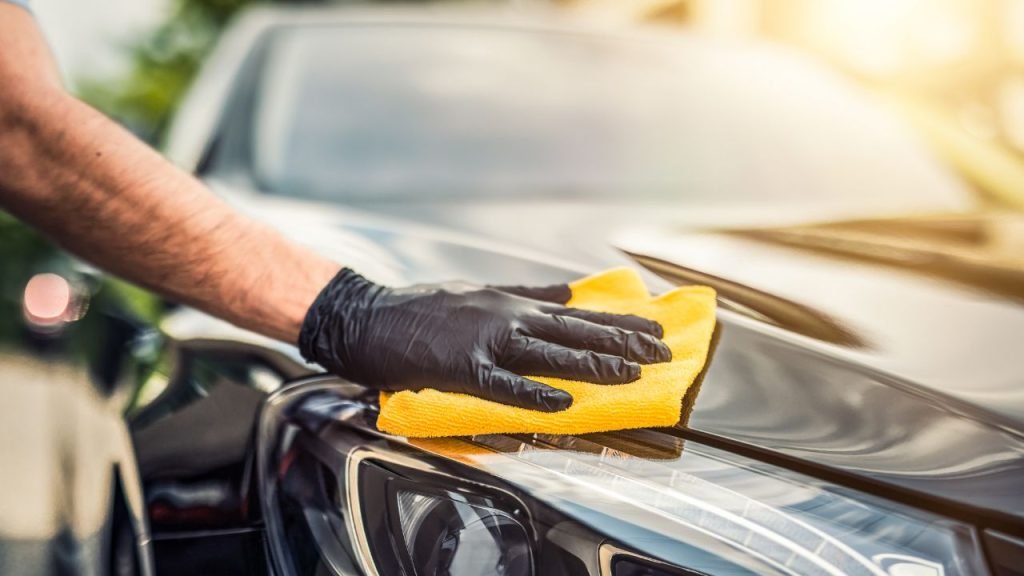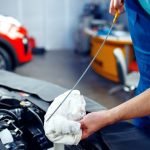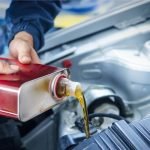Table of Contents
The Importance of Cleaning and Protecting Your Car’s Exterior in the Summer
Summer is here, and it’s time to hit the road for some fun in the sun. However, while you may be excited to make memories on your summer road trip, it’s important not to forget about taking care of your car during this season.
The hot temperatures can cause damage to your car’s exterior that can lead to costly repairs if not addressed. Therefore, it’s essential to clean and protect your car’s exterior from the harsh summer elements.
Cleaning and protecting your car’s exterior may seem like a daunting task, but it is crucial in prolonging the life of your vehicle. Sunlight, heat, and UV rays can fade paint color, cause oxidation on metal surfaces, and dry out rubber seals.
Dirt accumulated over time can also scratch the surface of the paint while acidic rainwater or bird droppings can corrode through unprotected paintwork. Maintaining a clean exterior helps reduce these risks and ensures that your vehicle looks good as new for years to come.
Brief Overview of Steps To Follow
Now that you know how important it is to clean and protect your car’s exterior during summer let’s review a quick overview of steps you should follow: 1) Gather Supplies – Collect all necessary cleaning supplies before starting.
2) Wash Your Car – Give your vehicle a proper wash using safe techniques.
3) Polish Your Car – Get rid of any contaminants remaining after washing.
4) Apply Wax or Sealant – Seal in shine with wax or sealant.
5) Protect Tires & Wheels – Keep tires healthy and shiny with proper maintenance
6) Clean Windows & Mirrors – Let sun shine through crystal clear glass.
In this article, we will go into greater detail about each step required for cleaning and protecting your car’s exterior in the summer. Let’s get started!
Gather Supplies
Before you get started on cleaning and protecting your car’s exterior, it’s important to gather all the necessary supplies. Here is a list of everything you’ll need:
Car Wash Soap
The first thing you’ll need is a good quality car wash soap. It’s important to use a soap that is specifically designed for cars, as regular household soaps can strip away wax or protective coatings on your car’s paint. Look for soap that has a pH balance around 7 or slightly lower.
Buckets
You’ll need two buckets: one for the soapy water and another for clean water. This prevents dirt and grime from getting back onto your car while you’re washing it.
Wash Mitts or Sponge
You’ll also need something to actually wash your car with, such as wash mitts or sponges. These should be made of microfiber or sheepskin material to avoid scratching your paint.
Towels or Chamois
Once you’re done washing, you’ll need something to dry off your car with. Microfiber towels are great at absorbing water without leaving any lint behind, while chamois are more absorbent but require more wringing out during use.
Polish or Compound (Optional)
If your car has scratches or swirl marks in the paint, then you may want to use a polishing compound to smooth them out. However, this step isn’t necessary if your paint is in good condition.
Carnauba Wax or Synthetic Sealant (Optional)
To protect your car’s paint from UV rays and other environmental factors, consider applying either carnuba wax (for a natural, warm glow) or a synthetic sealant (for longer-lasting protection). Choose the right product for your car’s color and age.
Tire Cleaner and Dressing
Don’t forget about your car’s tires! Use a specific tire cleaner to remove dirt and grime, and then apply a tire dressing to protect them from UV rays that can cause cracking. With all these supplies in hand, you’re ready to start cleaning and protecting your car’s exterior for the summer months ahead!
Wash Your Car: Tips for a Safe and Effective Wash
A proper car wash is essential to maintain the appearance and longevity of your vehicle’s exterior. However, it’s important to do it safely and carefully to avoid causing any damage.
Here are some tips for washing your car properly: First, start by rinsing off the car with a hose or pressure washer to remove any loose dirt or debris.
This will help prevent scratching the paint during the washing process. Next, use a high-quality pH-balanced soap that is specifically designed for cars.
Regular dish soap can strip the protective wax coating off your car’s paint, leaving it vulnerable to scratches and other types of damage. When washing your car, work from top to bottom in sections using a soft microfiber sponge or mitt.
Rinse the sponge frequently in clean water to help prevent dirt and debris from scratching the paint surface. Avoid using circular motions when washing as this can create swirls in the paint over time.
The Importance of Using a pH-Balanced Soap
Using a pH-balanced soap is important because it helps maintain the protective layer on your car’s paint. If you use an acidic soap such as dish soap or laundry detergent, it can strip away that layer which makes your vehicle more susceptible to damage from environmental factors like UV rays, salt spray from ocean air, acid rain drops etc.
How To Dry Your Car Without Leaving Water Spots
Drying your car properly after washing is crucial in preventing unsightly water spots on its surface. The best way to dry your car without leaving water spots is by using a microfiber towel or chamois cloth that has been specifically designed for drying cars.
Start by gently wiping down each section of your car with the towel/cloth until all moisture has been removed. If you notice any stubborn water spots left behind, you can use a detailing spray to help remove them.
Be sure to work quickly so that the water doesn’t have a chance to dry, leaving behind unwanted residue or marks. Remember: always be gentle when drying your car to avoid scratching the paint!
Polish Your Car
Why Polishing is Important
Before we get into the nitty-gritty of how to polish your car, let’s first talk about why it’s important. Polishing your car helps to remove any imperfections in the paint such as swirl marks, light scratches, and other minor blemishes that can accumulate over time.
These imperfections can make your car look dull and less shiny, which is why polishing is necessary to restore the paint’s depth and shine. In addition to improving the appearance of your car, polishing can also help protect the paint from further damage by creating a protective barrier against environmental factors such as UV rays and pollutants.
Types of Polish Based on Paint Condition
When it comes to choosing a polish for your car, there are different types available based on the condition of your paint. If you have relatively new paint that still has its shine intact, you may only need a light polish to maintain its appearance. On the other hand, if your car has more significant scratches or swirl marks, you may require a heavier cutting compound in order to remove these imperfections.
It’s important to choose a polish that matches the condition of your paint so that you don’t cause more damage than good. If you’re unsure about which type of polish is best for your car, consult with an auto detailing professional or do some research online before making a purchase.
How to Apply Polish Correctly
Now that you’ve chosen the right type of polish for your car’s condition, it’s time to apply it correctly. Begin by washing and drying your car thoroughly so that there are no leftover contaminants on the surface. Next, apply a small amount of polish onto an applicator pad and work it into one section at a time using circular motions.
Be sure not to press down too hard on the pad, as this can cause more scratches. You also want to avoid letting the polish dry on the surface, so be sure to work in small sections and remove any excess before moving onto the next section.
Once you’ve finished polishing your car, use a clean microfiber towel to buff off any remaining polish residue. Take a step back and admire your newly polished car – it’s sure to turn heads on the road!
Apply Wax or Sealant
Difference between Wax and Sealant
When it comes to protecting your car’s paint from the summer sun, you have two options: wax or sealant. The main difference between the two is that wax is derived from natural ingredients, while sealant is a synthetic polymer.
Wax provides a warm, glossy finish and offers protection against UV rays and water spots. However, it does not last as long as sealant and needs to be reapplied more frequently.
On the other hand, sealant lasts longer than wax and provides better protection against scratches, chips, and acid rain. It also has a more durable shine that can withstand harsh weather conditions.
Benefits of Using Wax or Sealant on Your Car’s Exterior in the Summer
The summer sun can be brutal on your car’s exterior paint. Without proper protection, UV rays can cause fading and discoloration over time.
Applying either wax or sealant to your car in the summer will provide an additional layer of protection against these damaging effects. In addition to protecting your car’s paint from harmful UV rays, both wax and sealant also offer protection against acidic bird droppings, tree sap, bug splatters, and other contaminants that can damage your car’s exterior.
The result? A well-maintained vehicle with a high resale value.
How to Apply Wax or Sealant
Applying wax or sealant to your car may seem like a daunting task at first but with some practice; you’ll find it easy enough to do on your own. Before applying any product make sure that you have thoroughly washed the car first. When it comes time for application use an applicator pad to spread out only enough of the product onto one panel at a time so that you can work quickly before it dries up.
Allow the wax or sealant to dry for the recommended amount of time, then remove it with a soft microfiber towel. Work in circular motions for better results.
Applying wax or sealant to your car’s exterior is an important step in protecting it from the elements. Choose the product that suits your needs, and follow the correct application techniques for a professional-looking finish.
Protect Your Tires and Wheels
Tips for Cleaning Tires and Wheels Properly
Cleaning your car’s wheels and tires is not only essential for maintaining their appearance, but also for ensuring that they remain in good condition. During the summer, the hot weather can cause rubber to dry out and crack, which can compromise the integrity of your tires. To prevent this from happening, it is important to clean your tires and wheels regularly.
To start, use a hose or pressure washer to rinse off any loose dirt or debris. Next, apply a wheel cleaner specifically designed for your type of wheels (alloy, chrome, etc.).
Use a stiff-bristled brush to scrub the cleaner into all areas of the wheel, including spokes and lug nuts. For cleaning tires, use a tire cleaner and applicator brush to remove any built-up grime or brake dust.
Importance of Using a Tire Protectant to Prevent Cracking in Hot Weather
In addition to regular cleaning, it is important to protect your tires from the harsh summer sun. UV rays can cause rubber to dry out over time and develop cracks, which can lead to blowouts on the road. To prevent this from happening, use a tire protectant that contains UV inhibitors.
After cleaning your tires thoroughly with a tire cleaner as described earlier in this article, apply tire protectant evenly across each tire using an applicator pad. Be sure not to get any on the tread area of the tire as it can affect traction while driving.
Allow the protectant several minutes to soak in before wiping off any excess with a microfiber towel. By following these tips for cleaning and protecting your car’s wheels and tires during summer months you’ll be able you’ll help extend their life expectancy while enhancing their visual appeal at same time!
Clean Windows and Mirrors
The Importance of Clear Vision
Keeping your car’s windows and mirrors clean is essential for safe driving. The last thing you want is to have a dirty windshield or side mirrors obscuring your view while you’re on the road.
Not only is it a safety hazard, but it’s also incredibly annoying. So, what’s the best way to clean your car’s windows and mirrors to avoid streaks and residue?
The Best Way to Clean Your Car’s Windows and Mirrors
First things first, avoid using household glass cleaners on your car’s windows and mirrors. These cleaners often contain ammonia, which can damage the tint on your car’s windows as well as other parts of the vehicle’s surface over time.
Instead, opt for a glass cleaner specifically designed for cars that has a pH-neutral formula. When cleaning your car’s windows and mirrors, make sure you start with a completely dry surface so that any loose dirt or dust doesn’t turn into mud when you start wiping with a cloth.
Use a microfiber towel or lint-free cloth to apply the glass cleaner in circular motions until all areas are covered. Then use another clean cloth or paper towel to wipe away the cleaner in straight lines from top-down.
To finish up, use another dry cloth or paper towel to buff any remaining streaks away from the window’s surface until they’re gone completely. If there are stubborn spots of grime still clinging on even after following these steps, try using some rubbing alcohol mixed with water in equal parts distilled water solution sprayed onto an area where required which will take care of those hard-to-remove stains without damaging window tinting films or causing scratches on windshields/mirrors.
Conclusion
Cleaning and protecting your car’s exterior in the summer is crucial for maintaining its appearance and value. By following the steps outlined in this article, you can ensure that your car stays in excellent condition all summer long. First, it’s important to gather all the necessary supplies before you begin.
This includes a bucket, pH-balanced soap, polish, wax or sealant, tire protectant, glass cleaner and microfiber towels. Next, you should wash your car thoroughly using a safe technique to avoid damaging its paint job.
Always use a pH-balanced soap and never use dish soap or other harsh detergents that can strip away protective coatings on your car’s exterior. After washing your car properly be sure to dry it thoroughly with a microfiber towel so as not to leave any water spots.
After washing the car correctly and drying it well apply polish that will help protect it from dirt and grime while giving it a deep shine. Using wax or sealant after is optional but highly recommended since they can keep paint protected from UV rays which may cause fading over time.
Don’t forget about the tires! Use a specialized tire protectant on them to prevent cracking due to hot weather conditions.
Cleaning windows and mirrors should also not be neglected as they are essential for visibility when driving. By following these steps mentioned above regularly during summer months you’re sure to keep your vehicle looking like new for years ahead!






